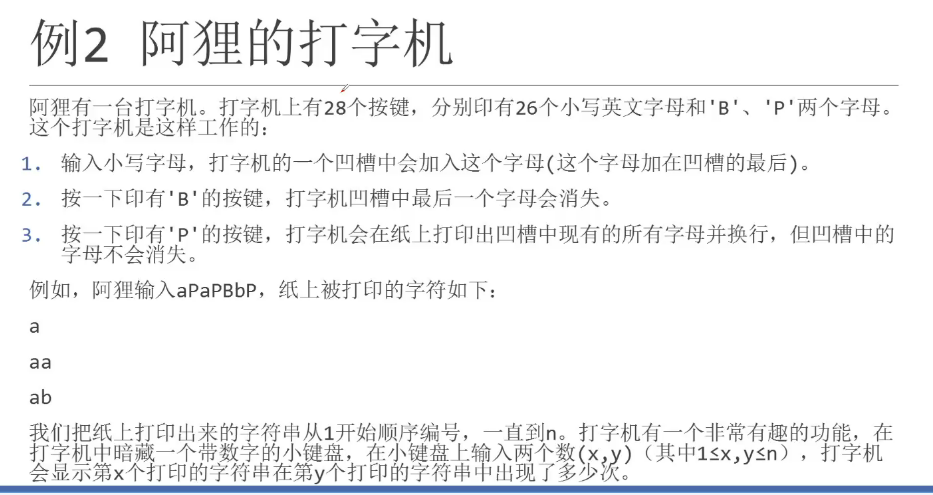题意:

1<=N<=10^5
1<=M<=10^5
输入总长<=10^5
思路:

From http://blog.csdn.net/lych_cys/article/details/50646799
首先你会发现他打字的方式非常奇妙。。实际上不就是在构建一颗Tire吗?P相当于给节点标记;B相当于退回父亲节点;a..z相当于建立新的节点。
然后跑AC自动机得到fail指针。
首先得知道如何得出单个操作x,y。在后缀数组(sam,后缀树等)中,判断u是v的子串的方法是看是否是每一个后缀的前缀;而AC自动机则架构在前缀树Tire上,自然地,判断AC自动机上面的两个子串u,v(AC自动机上的子串x可以看成是从根节点到节点x连成的一个字符串),u是否是v的子串,就等价于u是否是v某个前缀的后缀!在AC自动机上,判断u是x的后缀非常简单,只要看x能否沿着fail指针走到u即可。
那么,查询u在v中出现了几次就比较明了了,只要看从根节点到v的路径中有多少个x,满足u是x的后缀即x能沿着fail指针走到u。
于是,我们可以将fail[x]作为x(这里的x不同于上面的x)的父节点建立一颗新的树,这样的话如果i是j的祖先,那么j显然可以由fail指针走到i。那么查询u,v时,将root->v的路径上的每一个点都变为1,那么答案就相当于u的子树中有多少个1了。
但是这样直接在线查询显然不行(除非写一些高大上的数据结构)。单点修改子树查询可以用dfs序+树状数组解决,因此关键是减少修改次数。我们可以离线,以v为关键字排序,这样就可以根据原来建立AC自动机的顺序进行修改了,只要在进入一个点t时+1,出去时-1,查询时自然root->v的路径上的每一个点都是1了。
var map:array[0..150000,1..26]of longint; f,fa,ind,oud,q,t,x,y,id,head,vet,next,ans,num:array[1..150000]of longint; n,m,i,cnt,now,tot,j,k,len,time,u,que,tmp:longint; ch:ansistring; procedure acauto; var t,w,u,p,i,son:longint; begin t:=0; w:=1; q[1]:=1; while t<w do begin inc(t); u:=q[t]; for i:=1 to 26 do if map[u,i]>0 then begin son:=map[u,i]; p:=f[u]; if u=1 then f[son]:=1 else f[son]:=map[p,i]; inc(w); q[w]:=son; end else begin p:=f[u]; if u=1 then map[u,i]:=1 else map[u,i]:=map[p,i]; end; end; end; procedure add(a,b:longint); begin inc(tot); next[tot]:=head[a]; vet[tot]:=b; head[a]:=tot; end; procedure dfs(u:longint); var e,v:longint; begin inc(time); ind[u]:=time; oud[u]:=time; e:=head[u]; while e<>0 do begin v:=vet[e]; if ind[v]=0 then begin dfs(v); oud[u]:=oud[v]; end; e:=next[e]; end; end; procedure swap(var x,y:longint); var t:longint; begin t:=x; x:=y; y:=t; end; procedure qsort(l,r:longint); var i,j,t,mid:longint; begin i:=l; j:=r; mid:=y[(l+r)>>1]; repeat while mid>y[i] do inc(i); while mid<y[j] do dec(j); if i<=j then begin swap(x[i],x[j]); swap(y[i],y[j]); swap(id[i],id[j]); inc(i); dec(j); end; until i>j; if l<j then qsort(l,j); if i<r then qsort(i,r); end; function lowbit(x:longint):longint; begin exit(x and (-x)); end; procedure ins(x,y:longint); begin while x<=time do begin t[x]:=t[x]+y; x:=x+lowbit(x); end; end; function query(x:longint):longint; begin query:=0; while x>0 do begin query:=query+t[x]; x:=x-lowbit(x); end; end; begin assign(input,'bzoj2434.in'); reset(input); assign(output,'bzoj2434.out'); rewrite(output); readln(ch); m:=length(ch); len:=0; cnt:=1; now:=1; for i:=1 to m do begin case ch[i] of 'P': begin inc(n); num[n]:=now; continue; end; 'B': begin now:=fa[now]; continue; end; end; u:=ord(ch[i])-ord('a')+1; if map[now,u]=0 then begin inc(cnt); map[now,u]:=cnt; fa[cnt]:=now; end; now:=map[now,u]; end; acauto; for i:=2 to cnt do add(f[i],i); dfs(1); readln(que); for i:=1 to que do begin read(x[i],y[i]); id[i]:=i; end; qsort(1,que); j:=0; k:=1; now:=1; for i:=1 to m do begin case ch[i] of 'B': begin ins(ind[now],-1); now:=fa[now]; continue; end; 'P': begin inc(j); while (k<=que)and(y[k]=j) do begin tmp:=num[x[k]]; ans[id[k]]:=query(oud[tmp])-query(ind[tmp]-1); inc(k); end; continue; end; end; now:=map[now,ord(ch[i])-ord('a')+1]; ins(ind[now],1); end; for i:=1 to que do writeln(ans[i]); close(input); close(output); end.